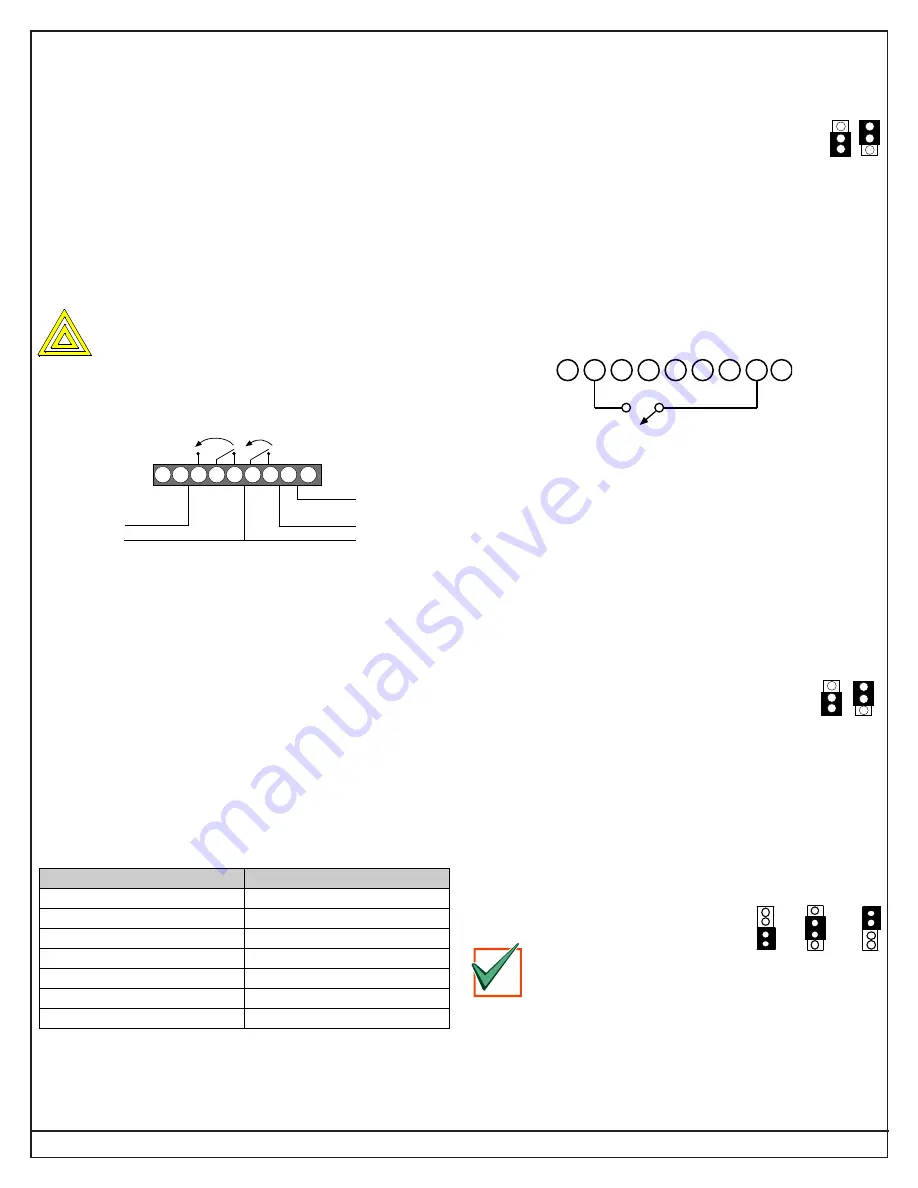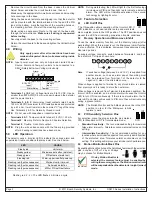
Page 2
© 2011 Bosch Security Systems, Inc.
DS970 Series Installation Instructions
•
Remove the circuit board from the base. Loosen the Vertical
Adjust Screw and slide the circuit board down, then out.
•
Break away the appropriate thin-wall wire entrance and mounting
hole coverings in the base.
•
Using the base as a template and aligning it so that the detector
will be mounted with the terminal block at the top and the PIR
lens at the bottom, mark the location of the mounting holes on
the mounting surface. Pre-start the mounting screws.
•
Route wiring as necessary. Route to the rear of the base and
through the wire entrance.
Make sure all wiring is unpowered
before routing.
•
Securely attach the base to the mounting surface.
•
Return the circuit board to the base and tighten the Vertical Adjust
Screw.
4.0
Wiring
CAUTION
Only apply power after all connections have been
made and inspected. Do not coil excess wiring inside
detector.
NOTE:
Input power must use only an Approved Limited Power
Source. Alarm and Tamper Contacts to be connected to a
SELV (Safety Extra-Low Voltage) circuit only.
– + NO C NC T T M
9-15 VDC
Input
Alarm Relay
Tamper
Memory
Input
TR Trouble
Alarm
1 2 3 4 5 6 7 8 9
•
Terminals 1 (–) & 2 (+):
Voltage limits are 9 to 15 VDC. Use no
smaller than #22 AWG (0.8 mm) wire pair between the detector
and the power source.
•
Terminals 3, 4, & 5
: Alarm relay (reed) contacts rated 3 watts,
125 mA, 28 VDC maximum for DC resistive loads and protected
by a 4.7 ohm, ½ watt resistor in the common "C" leg of the relay.
Use Terminals 4 & 5 for Normally Closed circuits.
NOTE:
Do not use with capacitive or inductive loads.
•
Terminals 6 & 7:
Tamper contacts rated at 28 VDC, 125 mA.
•
Terminal 8
: Memory. Refer to Section 6.0 Feature Selection.
•
Terminal 9
: Trouble. Solid State output.
NOTE:
Plug the wire entrance hole with the foam plug provided
after all wiring connections have been made.
5.0
LED Operation
The detector uses a tri-color LED to indicate the various alarm and
supervision trouble conditions that may exist. See chart below.
LED
CAUSE
Steady red
Unit alarm
Steady yellow
Microwave activation (walk test)
Steady green
PIR activation (walk test)
Flashing red
Warm-up period after power-up
Flashing red (2 pulse sequence)
Motion monitor time-out
Flashing red (3 pulse sequence)
Anti-mask detection
Flashing red (4 pulse sequence)
MW or PIR self-test failure
Flashing red 2 - 4 = The LED flashes 2-4 times a cycle.
NOTE:
During walk testing, the LED will light for the first technology
(microwave or PIR) and then light red to indicate a detector
alarm. The LED will not indicate activation of the second
technology by lighting its color.
6.0
Feature Selection
6.1
LED On/Off Pins
The ON position allows operation of the tri-color LED. If
LED indication is not desired after setup and walk tests
are completed, place in the OFF position. The OFF position does not
prevent the LED from indicating supervision trouble conditions.
6.2
Memory Operation and Microwave Inhibit
To use the alarm memory function, cut the Memory Jumper (after
walk testing). When this jumper is cut, the Microwave Inhibit function
is also activated. This eliminates microwave transmissions during
disarmed periods.
To supply voltage, connect a switch between Terminals 2 and 8 on
the detector’s T-strip as shown here:
1
2
3
4
5
6
7
8
9
Note
:
If switched voltage (between 9 and 15 V) is supplied from
another source, such as an alarm panel, then wiring must
also be provided from Terminal 1 of the detector to the
negative (-) side of the alternate source.
When voltage is applied to Terminal 8, any stored alarm is cleared
from memory and it is ready to store the next alarm.
When voltage is removed from Terminal 8 (disarmed condition), the
tri-color LED is enabled, and a stored alarm will cause the tri-color
LED to turn ON red continuously. If there is no stored alarm, the tri-
color LED and relay will respond to PIR only; they will activate only
during a present alarm.
NOTE:
The Motion Monitor and Anti-Mask pins must be in the OFF
position in order for the Microwave Inhibit
feature to work.
6.3
PIR Sensitivity Selection Pins
For selection, place the plug across the pins marked
STD for Standard or INT for Intermediate mode.
•
Standard Sensitivity:
The recommended setting for maximum
false alarm immunity. Tolerates environmental extremes on this
setting.
•
Intermediate Sensitivity:
The recommended setting for any
location where an intruder is expected to cover only a small portion
of the protected area. Tolerates normal environments on this
setting. This setting will improve your intruder catch performance.
6.4
Motion Monitor/Anti-Mask Pins
By enabling Motion Monitor and the Anti-Mask feature with the selection
pins, a choice of Off or 1 day or 30 days
may be chosen for Motion Monitor.
IMPORTANT
If 1-day Motion Monitor is
selected, the memory feature must be enabled by
cutting the memory jumper. The Motion monitor timer
will be suspended when the detector is in night (armed)
mode.
On
Off
INT
STD
Off
30
1





















